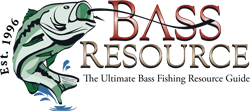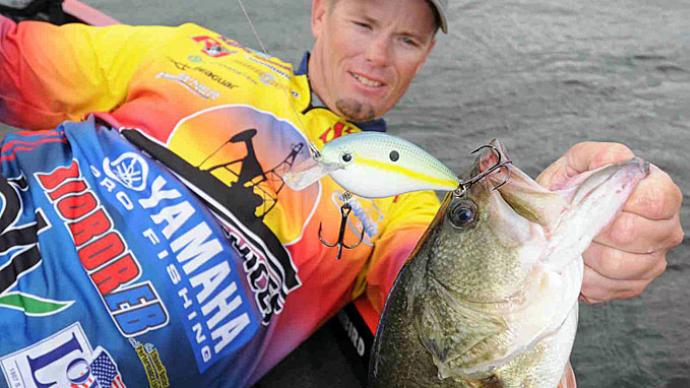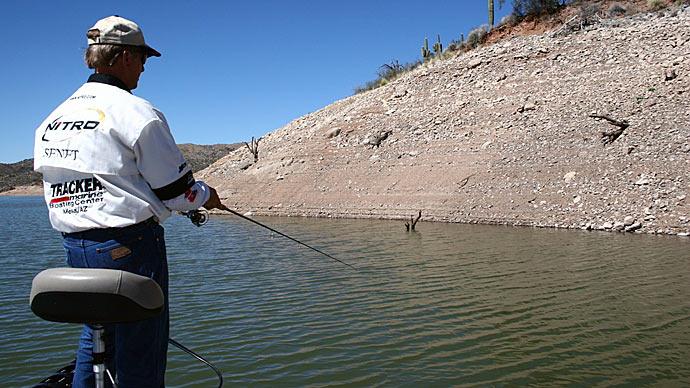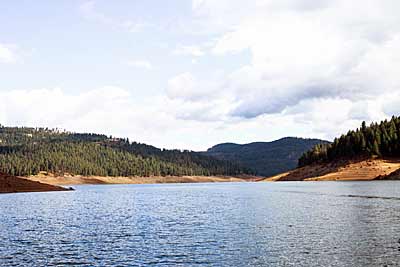
One of the biggest challenges in bass fishing is adapting to rising, and falling waters as bass are on the move. Their homes are getting smaller or bigger with each change in water level, and their movements are often sudden and unpredictable. This can make it difficult to locate groups of bass when the water is in flux.
Two Rules of Thumb
There's an adage in bass fishing that as waters rise, so do the bass. This is apparent when water levels rise and flood shoreline trees and bushes. As new cover becomes available for bass, they will often push shallow quickly in search of a new home or their next meal.
Newly flooded cover is always the first place to look during a recent high water push as bass will surely follow the water to the bank. It also works in reverse, as quickly dropping water will cause bass to vacate the shallow waters in search of a new home.
The first piece of cover in deeper water will often serve as a staging spot for fish until things settle down or the water continues to drop.
Generally, much higher water periods occur early in the year and result from spring rains or melting snow and ice at higher elevations. These factors increase the water levels in lakes, rivers, and reservoirs across the country.
Falling water tends to happen during the summer months and into the fall and winter and results from many different reasons. Irrigation and warmer air temperatures help to lower lake levels. Many bass fisheries also have scheduled drawdowns each fall to provide water to local communities and irrigation needs or brace for potential rising waters.
High Water Techniques
As waters rise, shoreline bushes, trees, and other shoreline objects suddenly become bass habitat. If this happens, there are several ways to target bass in their new locales.
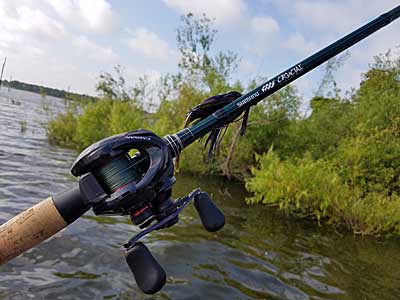
One of the best ways to fish newly flooded cover is by flipping and pitching. Depending on the thickness of the cover, a jig is one of the best and easiest things to use. Other options include Texas-Rigged soft plastics. This can be done with various weight sizes, again dependent on the thickness of the cover and how easily the jig or Texas-Rig can penetrate it.
For fishing faster, vibrating jigs, swim jigs, spinnerbaits, and topwaters are all practical tools for fishing in a high water situation. One more highly effective high water lure is a square bill crankbaits, a lure built to crash into cover, deflect and trigger strikes.
Low Water Tips and Tactics
As the water falls and bass-holding cover diminishes, whatever is left in the water becomes even more valuable. The lower water also helps congregate fish simply because there is less water and the same amount of bass. This can lead to excellent schooling action with fish ganging up on available cover and structure.
One of the best ways to catch fish in low water is to head to slightly deeper water and target fish with deep-diving crankbaits, football jigs, Carolina Rigs, and a drop-shot rig.
It doesn't have to be deep water fishing, though. If there are isolated stumps, rocks, and laydowns with enough water to physically hold a bass, a fish will likely be using it. Casting to anything left in the water will likely result in a fish catch. This can be done with Texas-Rigged soft plastics, jigs, or spinnerbaits. The key here is to find the remaining cover, and the bass will likely be on every piece you find that is deep enough to protect a bass.
When fishing during low water periods, it's good to mark things you see in the water with a waypoint. These isolated pieces of cover, rockpiles, humps, underwater points, and other key features can become amazing fishing locations when the water rises again. Another helpful visual tool is to take pictures of a lake during low-water periods. This gives you a complete picture of what's below the surface and can prove to be invaluable when the water comes back up and returns to normal levels.
Low Water Mapping
For lakes that rise and fall often, the mapping on your electronics can be wildly different from what you see on your depth readings. The electronic mapping from all brands is generally set with a depth reading at normal pool. That can be vastly different than the current conditions, so there are a handful of ways to combat that and better understand what you see on the map.
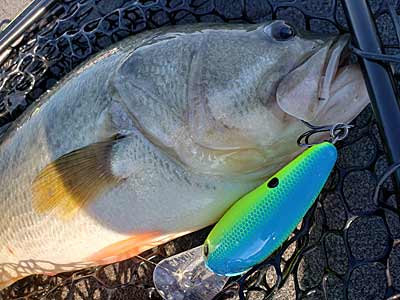
The easiest way to get the correct depth reading is to visit websites showing lake levels. This could be from power companies, dams, or lake organizations that monitor this data. Once you have that, you can get a number for how high or low the fishery is.
Some electronics brands have a mapping card feature that allows you to adjust the number to the correct level. There are also mapping apps that will enable you to adjust the water level to get an accurate depth reading on your mobile device. If you do not have access to those products, some simple math can give you a better picture of the correct depth once you know how high or low the water is.
Adjusting to rising and falling water levels is one of the most challenging situations that bass anglers face. The underwater environment changes, and bass move and adjust based on the changes. Knowing some general rules and adapting to the conditions can keep you ahead of the curve and allow you to continue catching bass no matter the water levels.
